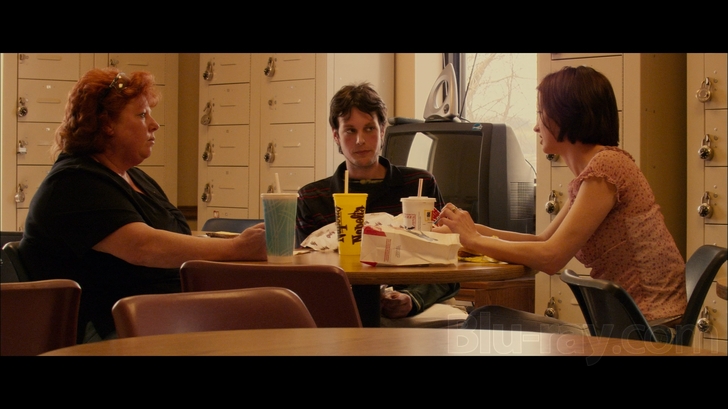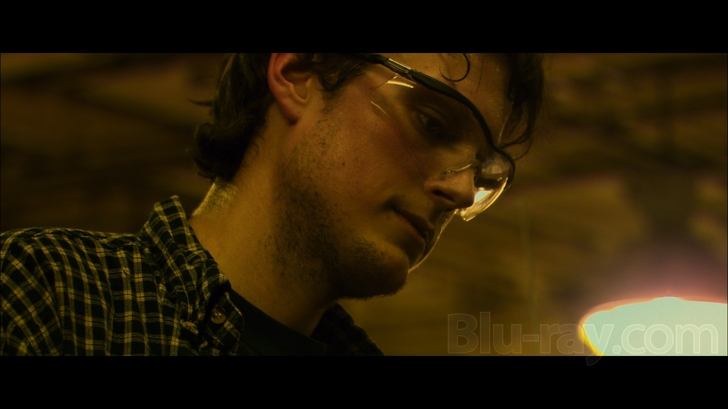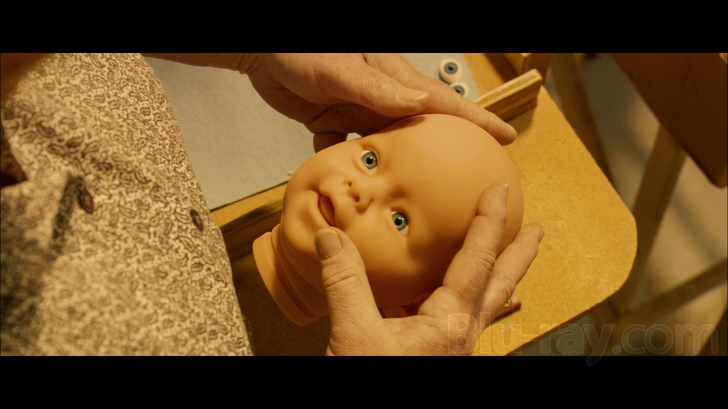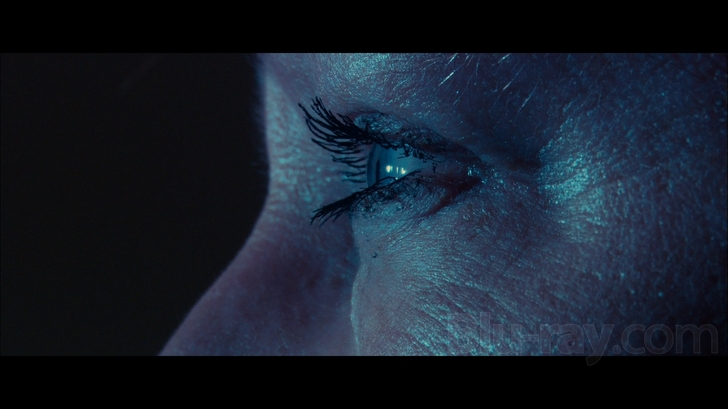Bubble Blu-ray Movie
HomeBubble Blu-ray Movie 
Magnolia Pictures | 2006 | 73 min | Rated R | Oct 10, 2006
Movie rating
6.7 | / 10 |
Blu-ray rating
| Users | 3.8 | |
| Reviewer | 2.5 | |
| Overall | 3.1 |
Overview
Bubble (2006)
In this unique cinematic experiment, acclaimed director Steven Soderbergh brings this tragic story to life with startling realism. A bizarre love triangle is born at a doll factory in a small Midwestern town. Lonely and isolated, long time employees Martha and Kyle have become friends by default in spite of their drastic age difference. Their dynamic is upset by the arrival of a new worker: young, attractive single mother Rose. As Martha grows increasingly wary about Rose's dubious character, she discovers Kyle and Rose developing a relationship of their own. When a murder investigation begins, it calls into question our established assumptions about these characters and life in their small town.
Starring: Debbie Doebereiner, Dustin Ashley, Misty Wilkins, Omar Cowan, Laurie L. WeeDirector: Steven Soderbergh
| Drama | Uncertain |
| Mystery | Uncertain |
| Crime | Uncertain |
Specifications
Video
Video codec: MPEG-2
Video resolution: 1080p
Aspect ratio: 2.40:1
Audio
English: Dolby Digital 3.0
English: DTS 3.0
Subtitles
English SDH, Spanish
Discs
25GB Blu-ray Disc
Single disc (1 BD)
Playback
Region free
Review
Rating summary
| Movie | 3.5 | |
| Video | 3.5 | |
| Audio | 2.0 | |
| Extras | 2.0 | |
| Overall | 2.5 |
Bubble Blu-ray Movie Review
Steven Soderbergh's path of least resistance is to be true.
Reviewed by Casey Broadwater July 17, 2009From the art-house sleeper to the big-budget blockbuster, and working with both no-name casts and Hollywood’s heaviest hitting A-list titans, director Steven Soderbergh’s wide ranging virtuosity has led Stephen Gaghan and others to call him “the Michael Jordan of filmmaking.” He may not be consistently good, but he’s always inventive and, more so, he doesn’t hesitate to re-invent his aesthetic when the story calls for it. His most striking departure is Bubble, a low-budget, HD-video feature that he undertook immediately after helming the star-powered, stylistic excesses of Ocean’s Twelve. The film caused a minor tizzy in industry circles, and its simultaneous release in theaters, on television, and on DVD led the CEO of the National Association of Theatre Owners to denounce this kind of release as “the biggest threat to the viability of the cinema industry today.” Dismissing the bunched panties of industry poobahs, Soderbergh claims hilariously on the commentary track for the film, “I don’t think it’s going to destroy the movie-going experience any more than the ability to get takeout has destroyed the restaurant business.” The film itself got somewhat lost in the huff over its release model, which is unfortunate because Bubble is an interesting experiment in low-cost, modern-day verité filmmaking.

Inordinate amounts of fast food are consumed in this film.
The film opens with a backhoe digging a grave in a cold and deserted cemetery. It’s an image that could easily be construed as a mere establishing shot, but it proves itself later to be a potent foreshadowing of the events to come. Set and filmed on location in Belpre, Ohio and Parksburg, West Virginia, Bubble explores the mundane lives led by a trio of workers at a local doll factory. Martha (Debbie Doebereiner) is an overweight, middle-aged woman who has found a friend in her coworker Kyle (Dustin James Ashley), a shy high school dropout with social anxiety disorder. They carpool to work—he doesn’t have a car—pick up breakfast together, and spend their lunch breaks chatting about everything and nothing. The dynamic is changed, however, when the factory hires Rose (Misty Dawn Wilkins), a young, attractive single-mother. As Kyle and Rose begin to spend more time with one another, Martha feels increasingly left-out, consigned to lonely nights caring for her elderly father.
To say more would spoil the rather thin story, but Bubble’s skeletal plot is, more than anything, a framework on which to hang Soderbergh’s tonal drapery. Character and mood are the highlights here, and despite the film’s short 74-minute run-time, Bubble’s narrative idles in park for forty minutes before deciding to go anywhere. And actually, the first time I watched the film, there wasn’t much I liked about it. The film is slow and ponderously true-to-life, like a documentary cut by an editor with no sense of pacing. On second viewing, though, I found myself thinking of Bubble less as a feature film, and more like a novella or a Raymond Carver short story, an honest, non-pejorative study of blue-collar lives in a stifled, industrial area that’s been abandoned by the American Dream. Bubble’s lingering attention to detail reminds that economic and mental depression are intrinsically linked. We see fast food wrappers littering the break room tables and Martha going out to restaurants alone to emotionally eat. We hear Kyle tell Rose that he doesn’t like open spaces with lots of people, and then notice that he lives in a tiny, wood-paneled womb of a room. It’s never spoken—it doesn’t need to be said—but it’s clear that the doll-making business has largely gone to China.
The film’s slow, small-scale literary quality won’t appeal to everyone, but there’s definitely a place for this kind of filmmaking, and Soderbergh uses Bubble to experiment with small, unobtrusive HD cameras and a cast of non-pro actors. The appearance and feel of the film is definitely jarring at first. We’re used to the poeticized image inherent in film’s depth of field, but the mid-range digital camera that Soderbergh uses here gives a picture that’s realistic and unflattering. That’s not to say, however, that it’s ugly, just that it doesn’t distance itself from reality like the 24 frames-per-second of film. Nearly every shot is a static, carefully composed tableau, and there are very few pans or movements by the camera. Soderbergh realizes that digital is the perfect medium for working with non-actors—the cameras are less noticeable, and video’s flat focus means the performers never have to worry about hitting marks or being in the right place. In fact, all of Soderbergh’s aesthetic and technical choices for Bubble seem aimed at removing all the artifices of filmmaking. There were no big lighting rigs or diffusers on set—just sunlight and whatever artificial light sources were present on location. The actors were wired, so that there were never boom mics hanging overhead. And most of the houses used in the film were the actor’s actual homes.
The performances are really what make the film worth watching. Writer Coleman Hough created an outline for the scenes, and Soderbergh basically let the cast improvise throughout. The first- time actors are awkward and real, reacting with genuine emotion and exhibiting vocal and facial ticks that an experienced actor would never dream up in a million years. And actually, if the film had been cast with recognizable stars, it would’ve been a big-time bore. The story is simply too thin to support three Hollywood heavyweights. Bubble’s appeal is the alternate reality that it creates, and while it may not have the most engaging narrative, it’s a striking and inventive example of how to think outside the box of the movie industry’s rigidly defined procedures.
Bubble Blu-ray Movie, Video Quality 

Due to the limitations of its video source material, Bubble's never going to look objectively great compared to Blu-ray's best. On its own merits, though, the film's 1080p, MPEG-2 transfer does work with a kind of beautiful ugliness that suits the story's depressed, small-town ambience. Since video has no mechanical motion—no film running through the gate—the stillness of Bubble's imagery mirrors the static nature of the characters' lives and professions. Close- ups look best, with crisp clarity that details every worry-line, pore, and blotchy skin texture. Mid to long shots, however, have a tendency to go soft and lose some contrast. Color seems problematic at first glance, but once you understand that the film was shot entirely with available light, sometimes with tungsten overheads and sunlight within the same shot, the inconsistent white balance makes total sense. The shortcomings of video also present themselves in hot or unbalanced contrast levels, with blacks that are either too dark or not dark enough, and whites that peak blindingly. Soderbergh is working within the limitations of the medium, though, and he manages to pull-off some stunning, verité shots that capture the trapped tedium of factory life.
Bubble Blu-ray Movie, Audio Quality 

With a meager Dolby Digital 3.0 track, Bubble's soundscape is as barren and desolate as the film's West Virginia scenery. Instead of using boom mics, which Soderbergh felt might hinder the naturalistic performances, he wired each actor individually and mixed the sound from those sources. What we get, then, is a shallow audio presentation that might as well be lifted out of a family home video. Voices are clear and clean, for the most part, but some lines can be lost in mumbled elocutions. Ambience, though, is nearly entirely absent, even in the doll factory, and there's no sound-design, per se, in the film at all—just a front and center presentation that never really engages. Robert Pollard, of Guided by Voices, contributes an acoustic guitar score—if you could call it that—but even though I like a lot of his music, it didn't really fit tonally with the film and the sound was entirely too brash and top-heavy at times.
Bubble Blu-ray Movie, Special Features and Extras 

Audio Commentary by Stephen Soderbergh and Mark Romanek
This is an excellent commentary track that really opened my eyes to some of the subtleties of the
film. Mark Romanek—known for his uber-creative music videos—is a great foil for Soderbergh,
asking him questions throughout and pushing for specifics. The two cover a lot of ground in the
film's brief 74-minute run time, from the origins of the story and process of casting non-pro
actors, to the freeing aspects of working with such a small crew and using a minimum amount of
equipment. One of the most interesting conversations is about the disparity between how people
in movies usually look and the appearance of "real" people. Aspiring digital filmmakers will
definitely want to give this one a listen, as Soderbergh really does cover all the bases.
Higher Definition: Bubble Episode (1080i, 25:42)
Dallas Observer film critic Robert Wilonsky interviews Soderbergh about his deal with HDNet and
the process of shooting an all-digital film. Literally all of the material is covered in the far more
substantive commentary track, however, so this comes off as a bit of a rehash. Still, it's there for
those who want to see it, and we even get a brief Terry Gilliam cameo at the end.
The disc also includes a three-minute HD preview of upcoming HDNet films, along with HD trailers
for Enron: The Smartest Guys in the Room, The War Within, Bikini
Destinations, and HDNet World Report Special: Shuttle Discovery's Historic
Mission.
Do note that, for whatever reason, the disc does not include the cast commentary,
director and
crew interviews, audition tapes, deleted scenes, and photo gallery that are present in the DVD
release. It seems ridiculous that the Blu-ray release—with almost infinitely more storage space—
would skimp on these extras.
Bubble Blu-ray Movie, Overall Score and Recommendation 

Bubble isn't for everyone. It creeps by at a plodding pace, nothing much happens, and the central mystery is easily unraveled. Still, I found myself enjoying the film for reasons that I can't quite explain. I suspect the film will be of most interest to those who are interested in the actual process of filmmaking, and not just the end result. It really is an intriguing example of how to work under budgetary and self-imposed constraints. I can't say that I recommend the film as a Blu-ray release though. If you enjoy the film and have the DVD already, I'd stick with that, as it definitely packs more heat in the bonus features department. For anyone else, I'd say Bubble is a very cautious rental.
Similar titles
Similar titles you might also like

Top of the Lake
2013

Cruising 4K
Limited Edition
1980

Mystic River
2003

American Gigolo 4K
Standard Edition
1980

In the Heat of the Night 4K
1967

Endeavour: Series 2
Masterpiece Mystery | Full UK-Length Edition
2014

The Killers
1946

They Call Me MISTER Tibbs!
1970

Clockers
1995

Wild Horses
2015

Prime Suspect 3
1993

Wallander - Series 2
Faceless Killers / The Man Who Smiled / The Fifth Woman
2010

The Laughing Policeman
1973

Bad Lieutenant: Port of Call New Orleans
2009

Insomnia
2002

Sharp Objects
2018

Bad Lieutenant 4K
1992

Animal Kingdom
2010

Cutter's Way
Limited Edition to 3000
1981

Thelma & Louise 4K
1991